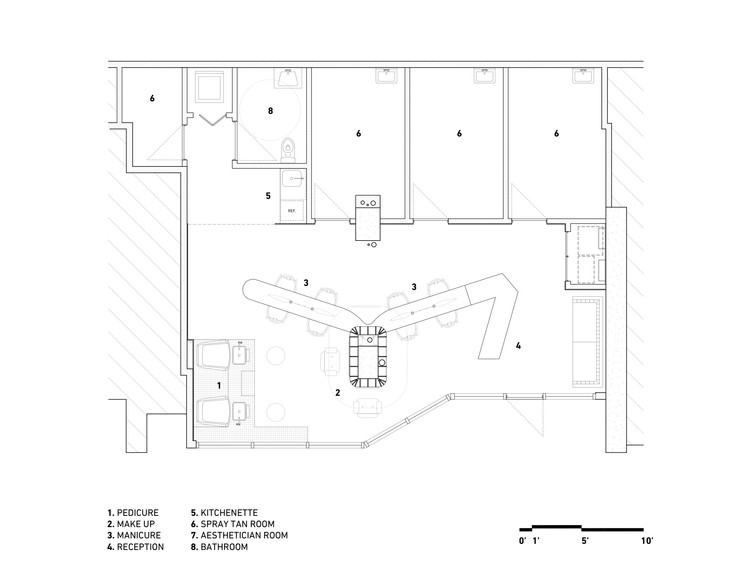Tortona 37 Multi
2013-09-21 00:00
架构师提供的文本描述。Via Tortona的改造是商人Alessandro Cajrati Crivelli在上世纪90年代开始的,目前仍在继续,显示出它完全有潜力重新开发和重新诠释这座大都市中一些最有趣的城市景点。Matteo Thun的Tortona 37项目
Text description provided by the architects. The transformation of Via Tortona, which was started by the businessman Alessandro Cajrati Crivelli back in the 1990s, is continuing, revealing its full potential for redeveloping and reinterpreting some of the most interesting urban spots in the metropolis. The Tortona 37 project by Matteo Thun & Partners is part of this healthy process of reusing the land and strengthening it through low environmental impact architecture. A building project which salvages a former industrial plant covering 25,000 square metres (it used to belong to General Electric) and restores it to the city through cutting-edge energy-efficient technology. Tortona 37 is a mixed-purpose architectural complex composed of five buildings set out like the courtyard around a garden planted with trees. Each rectangular-based building has 6 levels allowing double-exposures for the property units. They are double height (7 m) units generating open spaces with an interior mezzanine of great functional versatility. Here showrooms, laboratories, professional studios, shop and offices find their own custom design: the highly flexible interior spaces also ensure sustainably over time. An overhanging white lattice on the facade frames the wide glass windows of the entire complex, which culminates up on the roof with large terrace, authentic urban plazas with extensive views across the horizon.
每一个设计特点都是为了达到最大的能源效率,巧妙地协调建筑设计与植物工程:从空调系统沿地热线工作到在室内使用辐射板,以及对外壳进行仔细的研究。
Every design feature is aimed at achieving maximum energy efficiency, cleverly coordinating the architectural design with the plant-engineering: from the air-conditioning system working along geothermal lines to the use of radiant panels in the interiors and the careful study carried out for the outside shell.
玻璃外墙,结合在一个系统的外部窗帘,是非常有效地减少阳光的影响(高达87%),以防止内部过热在夏季。进一步的屏蔽是由木制百叶窗(一种“纯粹”使用的材料)在窗框和大的悬垂弓窗,使其形象自然演变的时间。
The glass facade, incorporated in a system of outside curtains, is highly efficient at reducing the impact of sunlight (up to 87%) to prevent the interiors from overheating during summer. Further screening is provided by the wooden shutters (a material used “purely”) on the window frames and large overhanging bow-windows, so that its image evolves naturally over time.
地热开发是生态可持续发展的前沿原则,但在意大利仍未经常使用,但被公认为提供了明确的环境效益。首先,地热能是一种免费的能源。米兰的地下水总是以恒定的温度供应,冬季比室外空气暖和,夏天比夏天凉爽:从能源角度看,这是一个非常有益的起点。
Geothermal exploitation is a cutting-edge principle of eco-sustainability, still not used very frequently in Italy but acknowledged as providing definite environmental benefits. First and foremost, geothermal energy is a free source of Energy. Milan’s ground water is always available at a constant temperature, warmer than the outside air in winter, cooler than it in summer: a highly beneficial starting point from an energy viewpoint.
37托托纳利用地热能,利用水/水多价热泵(甚至同时)创造热水和冷水,这是目前可利用的最有效的系统之一,对环境的影响最小。
37 Tortona exploits geothermal energy to create hot and cold water (even simultaneously) by means of water/water polyvalent heat pumps , one of the most efficient systems currently available causing least environmental impact.
四口井在14°C-16°C温度范围内,根据时间的不同抽取地下水。将水输送到地下集水罐和倾斜槽中,然后通过热泵将水输送给每个单独的建筑单元。
Four wells extract groundwater at a temperature of between 14°C-16°C depending on the time of year. The water is conveyed into an underground catchment and decantation tank and then supplied to each of the individual building units by means of heat pumps.
托托纳37使用一次空气和辐射天花板的混合系统,以适应室内的气候变化。托托纳37建筑群中使用的辐射天花板是水基热泵的理想补充,完美地创造了一个高效的能源系统。该面板由冬季的“低温热水”和夏季的“高温冷”水供应,只需最少的能源即可在第一年的不同时间运行。此外,环境温度是由辐射控制,没有噪音或气流,以确保最大舒适的地区被占领的人。一次空气由装有前处理电池的处理单元提供,这些电池也使用地下水。与传统系统相比,其主要优点是能源效率高,安装现场零排放,无声音或景观影响。
Tortona 37 uses a mixed system of primary air and radiant ceiling panels for climatising the interiors. The radiant ceiling panels used in the Tortona 37 complex are the ideal complement to the water-based heat pumps perfectly to create an efficient energy system. The panels are supplied by “low-temperature hot” water in winter and “high-temperature cold” water in summer and only require a minimum amount of energy to operate at various times of year1. Moreover, the ambient temperature is controlled by means of irradiation with no noise or air currents to ensure maximum comfort in the areas occupied by people. The primary air is provided by processing units fitted with pre-processing batteries also drawing on ground water. Compared to conventional systems, the main benefits are high energy efficiency, zero emission at the installation site, no sound or landscape impact.
Architects Matteo Thun & Partners
Category Office Buildings
Project Manager Luca Colombo
Design Team Tom Lacey, Francesco Isabella, Simone Alberi, Ilaria Brollo
Photographs Matteo Danesin, Daniele Domenicali
 举报
举报
别默默的看了,快登录帮我评论一下吧!:)
注册
登录
更多评论
相关文章
-

描边风设计中,最容易犯的8种问题分析
2018年走过了四分之一,LOGO设计趋势也清晰了LOGO设计
-

描边风设计中,最容易犯的8种问题分析
2018年走过了四分之一,LOGO设计趋势也清晰了LOGO设计
-

描边风设计中,最容易犯的8种问题分析
2018年走过了四分之一,LOGO设计趋势也清晰了LOGO设计




































































